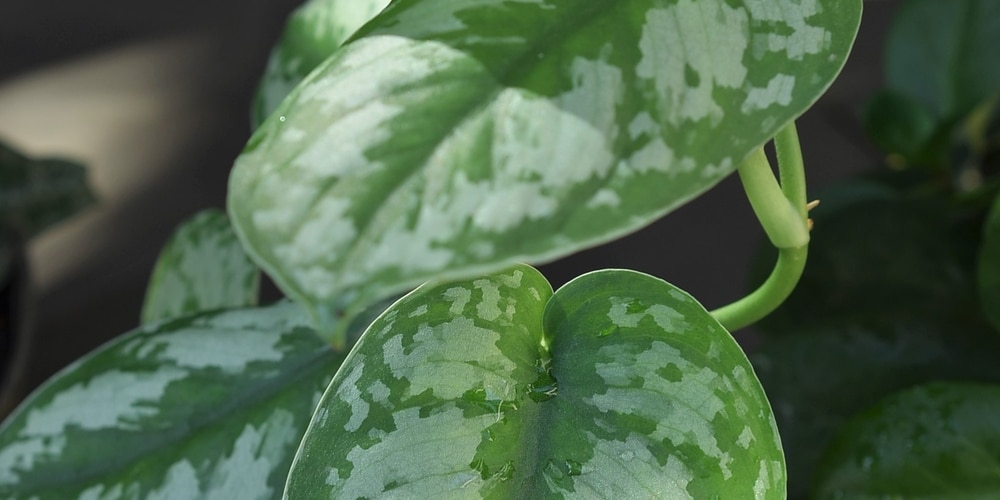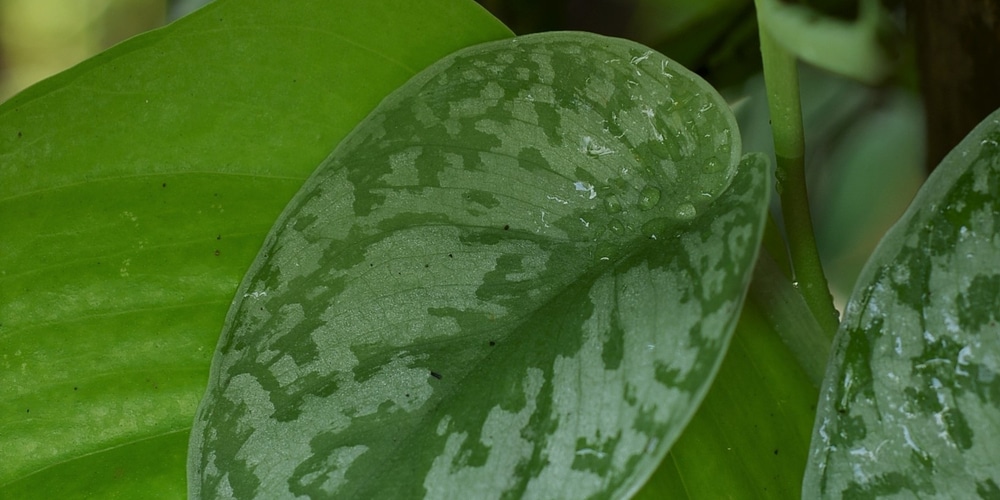The Scindapsus lucens is a rare plant species from the Scindapsus family. Its easy-going nature and ability to thrive in medium light conditions make it a no-fuss, beginner-friendly houseplant everyone can enjoy.

| Botanical Name | Scindapsus lucens |
| Common Name | Shingling Vine |
| Plant Type | Perennial |
| Flower Color | None |
| Size When Mature | 2 to 4 inches |
| Bloom Time | N/A |
| Sun Requirements | Bright light and shade |
| USDA Hardiness Zones | 9 to 11 |
| Soil PH Range | 6.1 to 6.5 |
| Soil Type | Free-draining |
| Water Needs | Medium |
| Native Area | Southeast Asia |
What you Need to Know About Scindapsus Lucens
Scindapsus Lucens is a vining plant that thrives in indoor settings, with silver-gray leaves that have highly accentuated veins. As the plant grows it forms vines and leaves, trailing downwards or crawling upwards if there’s a structure within reach.
Scindapsus plants are not known to flower, but they’re very easy to care for and have attractive foliage. The leaves and stems are toxic to humans as well as dogs and cats alike.
How to Care for Scindapsus Lucens
Here’s everything you need to know about growing and caring for a thriving Scindapsus Lucens.
Light
The Scindapsus lucens doesn’t need direct sunlight- it can stay indoors as long as there’s bright light and high enough humidity.
In its natural environment, scindapsus species are mostly found on forest floors and clinging to trees. Scindapsus lucens plants do very well in a bright environment with natural light, e.g., a window or an open space in the kitchen, for example.
In low-light conditions, the vining plant will lose its ‘luster’ and the silver-gray sheen will become a dull green. What’s more, its growth rate will be affected and your plant won’t look as healthy.
You can also bring the Scindapsus lucens outdoors but make sure that it’s in a shaded spot, such as a deck or patio. When winter comes it’s best to bring the plant inside.
Water and Soil Needs
Shingling vine plants are not particular about the type of soil they’re in. You can plant your Scindapsus lucens in regular garden soil or potting mix and it should do just fine. However, it’s worth noting that it can suffer from overwatering or a waterlogged medium which means you’ll be better off amending the soil with perlite or sand.
If you want to be sure, you can put your Scindapsus lucens in an aroid mix that’s typically used for philodendron plants and monsteras. Alternatively, bark orchid and peat moss work as well.
Scindapsus lucens love to get moisture either from the air or in their soil. You can mist the plant regularly or install a humidifier near it to make your plant happy. As for watering, a once-a-week schedule should suffice, but you should allow the soil to completely dry out first before you give the plant a drink.
Temperature Requirements
As an outdoor plant, Scindapsus lucens can be grown in USDA zones 9 through 11. The warm-loving species won’t likely survive winters in colder regions, but the good news is that you can always bring them inside to protect against frost.
Scindapsus lucens plant stays healthy in temperature ranges of 65 to 85 degrees F (or 18 to 29 degrees C) and can tolerate a bit of drought. Furthermore, it likes to have a humid environment of somewhere between 50 to 80 percent.
Fertilizer
The best fertilizer to use on a Scindapsus Lucens is a balanced and slow-release fertilizer.
In reality, these plants do not need fertilization at all and can thrive even with very few nutrients in the soil. If you’re inclined to do so, choose a slow-release fertilizer and only give a quarter dose every growing season.
Common Diseases
The most common pests of Scindapsus lucens are mealybugs, scale, and spider mites, although they’re very easy to spot and fix.
Check for these insects whenever you water by inspecting the soil, the stems, and the leaves. Apply a homemade insecticidal spray or neem oil as necessary to treat your plant and prevent serious infestations.
The plant is hardy enough to survive these pests and will usually spring right back when the problems are gone.
Scindapsus Lucens Propagation
Propagating a Scindapsus Lucens plant can be done via stem cuttings. All you’ll need is a sterilized pair of scissors or garden shears and a glass of water or a small pot of soil.
Choose a healthy stem at the trailing end of your plant with at least three leaves attached. The stem should have a node which the roots will grow from. Cut an inch below the node and place it in a ready pot with a well-draining medium, or a glass or bottle of clean water.
Leave the cutting in an area that gets bright indirect sun, and roots should grow in about 3 to 4 weeks.
Related Article: Jade Satin Scindapsus

